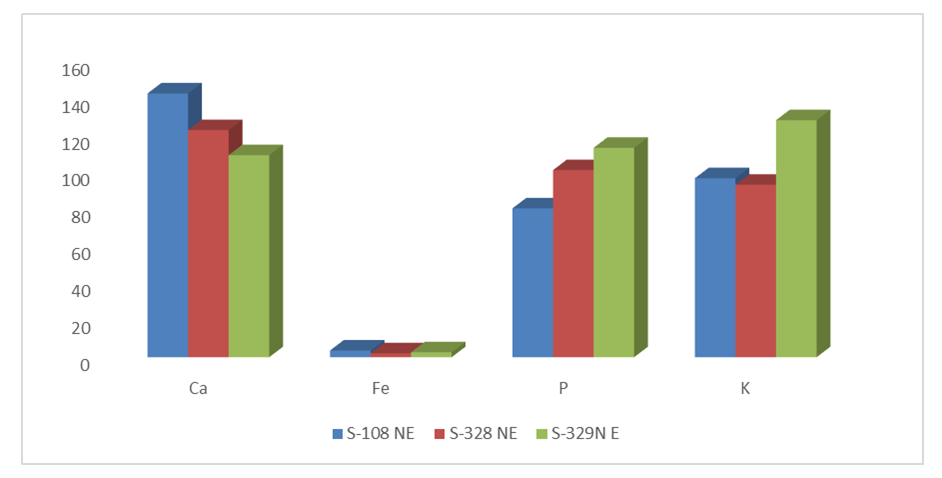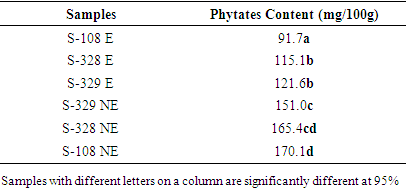-
Paper Information
- Paper Submission
-
Journal Information
- About This Journal
- Editorial Board
- Current Issue
- Archive
- Author Guidelines
- Contact Us
International Journal of Food Science and Nutrition Engineering
p-ISSN: 2166-5168 e-ISSN: 2166-5192
2022; 12(2): 37-40
doi:10.5923/j.food.20221202.01
Received: Sep. 6, 2022; Accepted: Sep. 21, 2022; Published: Oct. 12, 2022

Determination of Mineral Content and Effect of Parboiling on Phytate Contents of Sahel 108, Sahel 328 and Sahel 329 Rice Varieties Grown in the Senegal River Valley
Fallou Sarr1, 2, Abdou Diouf1, 2, Stephany E. A. T. Maganga2, Omar N. Faye3, Amadou Tidiane Guiro4
1Institut de Technologie Alimentaire (ITA), Route des Pères Maristes, BP 2756 Hann, Dakar, Sénégal
2Faculté des Sciences et Techniques (FST), Université Cheikh Anta Diop de Dakar (UCAD), BP 5005 Fann, Dakar, Sénégal
3Centre de Recherches Agricoles de Saint Louis, Institut Sénégalais de Recherches Agricoles (ISRA), Bel Air, Route des Hydrocarbures, BP 3120 Dakar, Sénégal
4Laboratoire de Nutrition et d'Alimentation Humaine (LARNAH), Département de Biologie Animale, Faculté des Sciences et Techniques (FST), Université Cheikh Anta Diop de Dakar (UCAD), BP 5005 Fann, Dakar, Sénégal
Correspondence to: Fallou Sarr, Institut de Technologie Alimentaire (ITA), Route des Pères Maristes, BP 2756 Hann, Dakar, Sénégal.
| Email: |  |
Copyright © 2022 The Author(s). Published by Scientific & Academic Publishing.
This work is licensed under the Creative Commons Attribution International License (CC BY).
http://creativecommons.org/licenses/by/4.0/

The purpose of this study was to determine the mineral contents (Fe, Ca, P, K) and to study the effect of parboiling on the phytate contents of rice varieties Sahel 108, Sahel 328 and Sahel 329 cultivated and consumed in Senegal. For each rice varieties studied, 1 kg of paddy was collected as a sample, cleaned and then soaked at 80°C for 16 hours. Afterwards, phytate and mineral contents were quantified. The study found a calcium content ranged from 108.96 to 142.25 mg/100g. For iron content, 3.61, 2.10 and 2.66 mg/100g were obtained for Sahel 108, Sahel 328 and Sahel 329, respectively. These different results shown that Sahel 108 presented the highest iron and calcium contents. Concerning phosphorus and potassium contents, 80.28, 100.89 mg/100g and 112.91 and 96.53, 92.99 and 127.83 mg/100g were, respectively for Sahel 108, Sahel 328 and Sahel 329. For these two minerals, Sahel 108 presented the lowest content. The results shown that all the untreated samples had similar phytate contents varying from 151.0 mg/100g to 170.1 mg/100g. The study revealed that, in one hand the rice varieties Sahel 108, Sahel 328 and Sahel 329 also contained phytates that inhibit the bioavailability of minerals like iron and in another hand, parboiling reduced significantly phytate levels while preserving mineral elements.
Keywords: Rice, Phytates, Minerals, Parboiling, Senegal River valley
Cite this paper: Fallou Sarr, Abdou Diouf, Stephany E. A. T. Maganga, Omar N. Faye, Amadou Tidiane Guiro, Determination of Mineral Content and Effect of Parboiling on Phytate Contents of Sahel 108, Sahel 328 and Sahel 329 Rice Varieties Grown in the Senegal River Valley, International Journal of Food Science and Nutrition Engineering, Vol. 12 No. 2, 2022, pp. 37-40. doi: 10.5923/j.food.20221202.01.
Article Outline
1. Introduction
- Rice is one of the most important cereal in the world for human consumption. According to FAO [1], world production of milled rice is estimated at 511.2 million tons in the 2019/2020 season. In Senegal, this production amounted to 1,155,337 tons for the same period [2].In Africa, rice consumption increases due to urbanization and changes in consumer food preferences [3]. Indeed, sub-Saharan Africa alone recorded more than 32 million tons of rice consumed in 2018/2019 according to USDA [4].In Senegal the average of annual rice consumption is estimated at 1,080,000 tons, of which 650,000 come from imports and 430,000 from national production according to Galán and Drago [5]. Rice is an important source of minerals and vitamin B for human beings. Minerals are essential nutrients for human health because they play an important role in the physiological processes of the human body [5]. To this end, thiamine is closely related to normal glucose metabolism in the brain and its deficiency can weaken human memory [6]. In addition, studies have shown that rice varieties contain iron varying between 11.25 and 14.17 mg/kg, zinc 37.5 mg/kg and calcium 19.93 mg/kg [7] [8]. Like many other grains, rice contains anti-nutritional factors that reduce the availability of its nutrients. Among other anti-nutritional factors, phytates are one of the more known. Indeed, the presence of phytates in food is associated with a reduced absorption of minerals due to their structure allowing them to form very stable complexes with mineral ions [9].In 2009, Norhaizan and Nor [7] found phytate levels ranging from 36.40 to 76.24 mg/100g in rice samples and rice products. Tamanna and al. [10] also found higher phytate contents in rice samples ranging from 405 to 635 mg/100g.To reduce the effect of phytates on minerals, several technological methods have been used. These were mainly dehulling, cold soaking and sprouting, among others. Dehulling is a method that is carried out by abrasion of the grain, causing the elimination of the bran where a very important part of the phytates is located. Cold soaking is often used in cereal processing to reduce phytates. Germination is a period in the life cycle of plants when they begin to emerge from the seed. It increases the availability of nutrients in grains by reducing phytates with activation of enzymes.Although, all of these processes significantly reduce the phytate contents of grains generally and rice particularly, they also lead for mineral losses. Their application also remains limited because of the additional workload they impose or the particular organoleptic properties they induce. Thus, it is urgent to find an alternative process which reduces both the phytate contents and the mineral losses.For paddy rice, Nadia et al. [11] demonstrated that parboiling is a post-harvest process that significantly reduces nutrient losses during shelling and cooking. Thus, the purpose of this study was to determine the mineral contents (Fe, Ca, P, K) and to study the effect of parboiling on the phytate contents of rice varieties Sahel 108, Sahel 328 and Sahel 329 cultivated and consumed in Senegal.
2. Material and Methods
- The plant material used in this study consisted of three rice varieties Sahel 108, Sahel 328 and Sahel 329. Samples were taken in test plots from Mbagam in the Senegal River valley conducted by Centre de Recherches Agricoles de Saint Louis.
2.1. Parboiling
- For each rice varieties studied, one (1) kg of paddy was collected as a sample, cleaned and then soaked at 80°C for 16 hours. The precooked rice was dried until an average water content of 14% before husking using an Engelberg machine.
2.2. Preparation of Samples for Analysis
- For each variety, there was an un-parboiled (NE) and a parboiled (E) samples. These were for Sahel 108 respectively S-108 NE and S-108 E, for Sahel 328 S-328 NE and S-328 E and for Sahel 329 S-329 NE and S-329 E.For each sample, 100g of rice was taken, ground using a mill 3100 brand of laboratory mill, packaged in polyethylene bags and kept at 4°C until use.
2.3. Determination of Phytates
- The method described by Latta and Eskin [12] and Vaintraub and Lapteva [13] was used with a slight modification. Thus, sample of 1.2g was placed in a 50 ml tube, in which 40 ml solution of 2.4% HCl was added. The tubes were left at room temperature for 2 hours. Thus, each tube was vortexed for 15 seconds, every 10 minutes. After 2 hours, the tubes were centrifuged at 2800 rpm for 30 minutes. Then, 5 ml of the obtained supernatant was diluted in 45 ml dionized water before homogenizing. A 5 ml of Wade's rose was added to 15 ml aliquot of the previous solution. The reading was done at 500 nm using UV spectrophotometer.
2.4. Determination of Minerals
- The mineral contents were determined according to AOAC [14] method. The method consists to measure the elements by Atomic Absorption Spectrophotometry after sample incineration and dissolution of the ash into hydrochloric acid solution. Minerals content in samples were determined using calibration curves from established range of standard solutions.
3. Results and Discussion
3.1. Minerals Content of the Three Varieties Sahel 108, Sahel 328 and Sahel 329
- The mineral contents of the studied rice samples were shown in figure 1. These were calcium, iron, phosphorus and potassium.
 | Figure 1. Variation of minerals content depending on rice variety |
3.2. Effect of Parboiling on Phytate Contents
- Table 1 shown the phytate contents of all studied rice samples.
|
4. Conclusions
- It emerged from this study that Sahel 108, Sahel 328 and Sahel 329 rice varieties were good food sources of calcium and iron and can be used to improve the nutritional status of populations, especially in developing countries. But it appeared that all rice varieties Sahel 108, Sahel 328 and Sahel 329 contained phytates which inhibit the bioavailability of minerals like iron. So, the study revealed that parboiling significantly reduced phytate levels while preserving mineral elements. However, a comparative study of the mineral content of these rice varieties, both parboiled and non-parboiled, will be implemented to study the effect of parboiling on mineral preservation.
Conflict of Interests
- The authors declared that this manuscript has not been submitted to any journal for publication. They also declared have read and approved the requirements and all are aware of its submission to International Journal of Food Science and Nutrition Engineering.
ACKNOWLEDGEMENTS
- The authors acknowledged USAID FEED THE FUTURE Sustainable Intensification Innovation Lab (SILL) project supported this work.
 Abstract
Abstract Reference
Reference Full-Text PDF
Full-Text PDF Full-text HTML
Full-text HTML